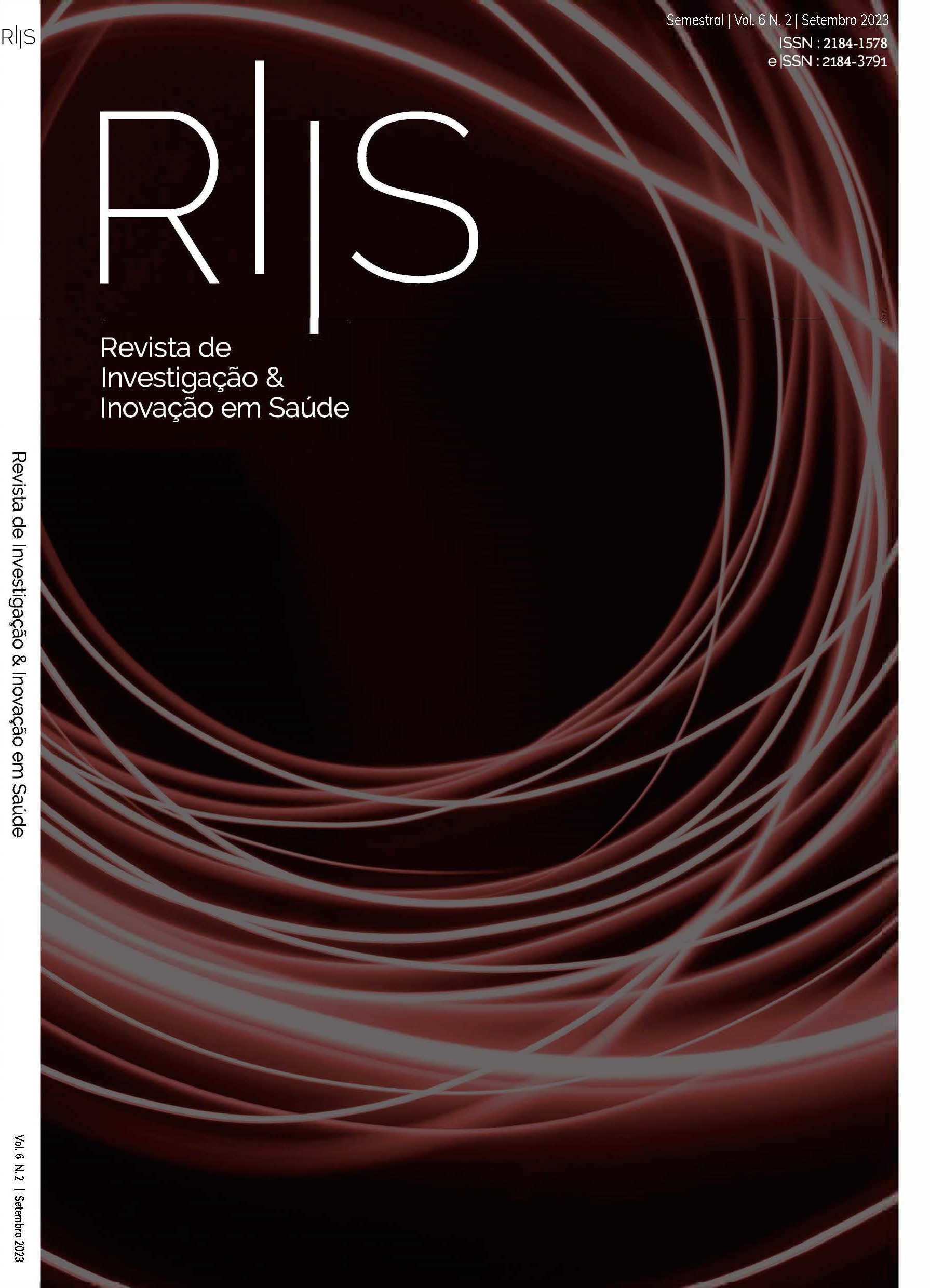La efectividad del oxígeno de alto flujo nasal en la insuficiencia respiratoria: revisión sistemática
DOI:
https://doi.org/10.37914/riis.v6i2.235Resumen
Marco contextual: la insuficiencia respiratoria es un síndrome que tiene un gran impacto en los ingresos hospitalarios, la morbilidad y mortalidad. La aplicabilidad del oxígeno nasal de alto flujo ha sido objeto de interés en pacientes críticos. Objetivo: conocer la efectividad del oxígeno nasal de alto flujo en el tratamiento de la insuficiencia respiratoria en adultos en unidades de cuidados intensivos. Métodos: revision sistemática de efectividad utilizando la estrategia PICO y recomendaciones del Instituto Joanna Briggs. La búsqueda se llevó a cabo en agosto de 2021 utilizando las plataformas de acceso PubMed y EBSCOhost. Resultados: se identificaron 583 resultados. Se analizaron seis ensayos clínicos aleatorios. La selección se realizó después de la eliminación de duplicados; lectura de títulos, de resúmenes y de texto completo siguiendo el diagrama Preferred Reporting Items for Systematic Reviews and Meta-Analyses. Conclusión: el Oxígeno nasal de alto flujo demostró ser cómodo, tolerable y eficaz en el tratamiento de la insuficiencia respiratoria hipoxémica e hipercápnica. Fue eficaz en comparación con la oxigenoterapia convencional en la postextubación de pacientes hipoxémicos y en la reducción de la presión parcial de dióxido de carbono en comparación con la Ventilación No Invasiva en pacientes hipercápnicos.
Citas
Gomes, A. J., Ramos, S., Vieira, C., Pinho, A., Rego, A., & Macedo A.P. (2021). . The Effectiveness of high-flow oxygen in the respiratory insufficiency: Systematic review. PROSPERO CRD42021271482. https://www.crd.york.ac.uk/prospero/display_record.php?ID=CRD42021271482
Aromataris, E., & Munn, Z. (2020a). Chapter 1: JBI Systematic Reviews. In: Aromataris E., Munn Z. Editor. JBI Manual for Evidence Synthesis. https://doi.org/10.46658/JBIMES-20-02 DOI: https://doi.org/10.46658/JBIRM-17-01
Aromataris, E., Munn, Z. (Eds) (2020b). JBI Manual for Evidence Synthesis. JBI. https://synthesismanual.jbi.global/
Azoulay, E., Lemiale, V., Mokart, D., Nseir, S., Argaud, L., Pène, F., ... & Demoule, A. (2018). Effect of high-flow nasal oxygen vs standard oxygen on 28-day mortality in immunocompromised patients with acute respiratory failure: the HIGH randomized clinical trial. Jama, 320(20), 2099-2107. http://dx.doi.org/10.1001/jama.2018.14282 DOI: https://doi.org/10.1001/jama.2018.14282
Bellani, G., Laffey, J. G., Pham, T., Fan, E., Brochard, L., Esteban, A., Gattinoni, L., van Haren, F., Larsson, A., McAuley, D. F., Ranieri, M., Rubenfeld, G., Thompson, B. T., Wrigge, H., Slutsky, A. S., Pesenti, A., LUNG SAFE Investigators, & ESICM Trials Group (2016). Epidemiology, Patterns of Care, and Mortality for Patients With Acute Respiratory Distress Syndrome in Intensive Care Units in 50 Countries. JAMA,315(8), 788–800. https://doi.org/10.1001/jama.2016.0291 DOI: https://doi.org/10.1001/jama.2016.0291
Cumpston, M., Li, T., Page, M. J., Chandler, J., Welch, V. A., Higgins, J. P., & Thomas, J. (2019). Updated guidance for trusted systematic reviews: a new edition of the Cochrane Handbook for Systematic Reviews of Interventions. The Cochrane database of systematic reviews, 10, ED000142. https://doi.org/10.1002/14651858.ED000142 DOI: https://doi.org/10.1002/14651858.ED000142
Dres, M., & Demoule, A. (2017). What every intensivist should know about using high-flow nasal oxygen for critically ill patients. Revista Brasileira de Terapia Intensiva, 29, 399-403. https://doi.org/10.5935/0103-507X.20170060 DOI: https://doi.org/10.5935/0103-507X.20170060
Frat, J. P., Ragot, S., Girault, C., Perbet, S., Prat, G., Boulain, T., Demoule, A., Ricard, J. D., Coudroy, R., Robert, R., Mercat, A., Brochard, L., Thille, A. W., & REVA network (2016). Effect of non-invasive oxygenation strategies in immunocompromised patients with severe acute respiratory failure: a post-hoc analysis of a randomised trial. The Lancet. Respiratory medicine, 4(8), 646–652. https://doi.org/10.1016/S2213-2600(16)30093-5 DOI: https://doi.org/10.1016/S2213-2600(16)30093-5
Frat, J. P., Ricard, J. D., Quenot, J. P., Pichon, N., Demoule, A., Forel, J. M., Mira, J. P., Coudroy, R., Berquier, G., Voisin, B., Colin, G., Pons, B., Danin, P. E., Devaquet, J., Prat, G., Clere-Jehl, R., Petitpas, F., Vivier, E., Razazi, K., Nay, M. A., … REVA network (2019). Non-invasive ventilation versus high-flow nasal cannula oxygen therapy with apnoeic oxygenation for preoxygenation before intubation of patients with acute hypoxaemic respiratory failure: a randomised, multicentre, open-label trial. The Lancet. Respiratory medicine, 7(4), 303–312. https://doi.org/10.1016/S2213-2600(19)30048-7 DOI: https://doi.org/10.1016/S2213-2600(19)30048-7
Frat, J. P., Thille, A. W., Mercat, A., Girault, C., Ragot, S., Perbet, S., Prat, G., Boulain, T., Morawiec, E., Cottereau, A., Devaquet, J., Nseir, S., Razazi, K., Mira, J. P., Argaud, L., Chakarian, J. C., Ricard, J. D., Wittebole, X., Chevalier, S., Herbland, A., … REVA Network (2015). High-flow oxygen through nasal cannula in acute hypoxemic respiratory failure. The New England journal of medicine, 372(23), 2185–2196. https://doi.org/10.1056/NEJMoa1503326 DOI: https://doi.org/10.1056/NEJMoa1503326
Gomes, M. J. M., & Sotto-Mayor, R. (2001). 25 perguntas frequentes em pneumologia. Permanyer
Gotera, C., Lobato, S. D., Pinto, T., & Winck, J. C. (2013). Clinical evidence on high flow oxygen therapy and active humidification in adults. Revista portuguesa de pneumologia, 19(5), 217-227. http://dx.doi.org/10.1016/j.rppneu.2013.03.005 DOI: https://doi.org/10.1016/j.rppneu.2013.03.005
Ischaki, E., Pantazopoulos, I., & Zakynthinos, S. (2017). Nasal high flow therapy: a novel treatment rather than a more expensive oxygen device. European Respiratory Review, 26(145). http://dx.doi.org/10.1183/16000617.0028-2017 DOI: https://doi.org/10.1183/16000617.0028-2017
Joanna Briggs Institute. (2013). New JBI Levels of Evidence. http://joannabriggs-webdev.org/assets/docs/approach/JBI-Levels-of-evidence_2014.pdf
Martins, A. (2019). Insuficiência Respiratória Aguda. Medicina Interna 4(26), 342-344. https://doi.org/10.24950/rspmi/ce/204/19/4/2019 DOI: https://doi.org/10.24950/rspmi/CE/204/19/4/2019
Mauri, T., Turrini, C., Eronia, N., Grasselli, G., Volta, C. A., Bellani, G., & Pesenti, A. (2017). Physiologic effects of high-flow nasal cannula in acute hypoxemic respiratory failure. American journal of respiratory and critical care medicine, 195(9), 1207-1215. http://dx.doi.org/10.1164/rccm.201605-0916oc DOI: https://doi.org/10.1164/rccm.201605-0916OC
Moher, D., Liberati, A., Tetzlaff, J., & Altman, D. G. (2009). Preferred Reporting Items for Systematic Reviews and Meta-Analyses: The PRISMA Statement. Annals of Internal Medicine. 151(4), 264. http://dx.doi.org/10.7326/0003-4819-151-4-200908180-00135 DOI: https://doi.org/10.7326/0003-4819-151-4-200908180-00135
Nicolini, A., Ferrera, L., Santo, M., Ferrari-Bravo, M., Del Forno, M., & Sclifò, F. (2014). Noninvasive ventilation for hypercapnic exacerbation of chronic obstructive pulmonary disease: factors related to noninvasive ventilation failure. Pol Arch Med Wewn, 124(10), 525. http://dx.doi.org/10.20452/pamw.2460 DOI: https://doi.org/10.20452/pamw.2460
Nishimura, M. (2015). High-flow nasal cannula oxygen therapy in adults. Journal of intensive care, 3(1), 1-8. http://dx.doi.org/10.1186/s40560-015-0084-5 DOI: https://doi.org/10.1186/s40560-015-0084-5
Pádua, A. I., Alvares, F., & Martinez, J. A. B. (2003). Insuficiência Respiratória. Medicina, 36(2/4), 205. https://doi.org/10.11606/issn.2176-7262.v36i2/4p205-213 DOI: https://doi.org/10.11606/issn.2176-7262.v36i2/4p205-213
Papachatzakis, Y., Nikolaidis, P. T., Kontogiannis, S., & Trakada, G. (2020). High-flow oxygen through nasal cannula vs. non-invasive ventilation in hypercapnic respiratory failure: a randomized clinical trial. International journal of environmental research and public health, 17(16), 5994. http://dx.doi.org/10.3390/ijerph17165994 DOI: https://doi.org/10.3390/ijerph17165994
Roussos, C., & Koutsoukou, A. (2003) Respiratory failure. European Respiratory Journal, 22(47 suppl), 3s-14s. https://doi.org/10.1183/09031936.03.00038503 DOI: https://doi.org/10.1183/09031936.03.00038503
Santos, A. C. (2018). 13º Relatório do Observatório Nacional das Doenças Respiratórias 2016/2017. Panorama das doenças respiratórias em Portugal. Retrato da saúde 2018. O estado da Saúde em Portugal. https://www.ondr.pt/files/Relatorio_ONDR_2018.pdf
Scala, R., & Heunks, L. (2018). Highlights in acute respiratory failure. European Respiratory Review,27(147). https://doi.org/10.1183/16000617.0008-2018 DOI: https://doi.org/10.1183/16000617.0008-2018
Simon, M., Wachs, C., Braune, S., de Heer, G., Frings, D., & Kluge, S. (2016). High flow nasal cannula oxygen versus bag-valve-mask for preoxygenation before intubation in patients with hypoxemic respiratory failure–a randomized controlled trial. Pneumologie, 70(S 01), P381. http://dx.doi.org/10.4187/respcare.04413 DOI: https://doi.org/10.1055/s-0036-1572106
Song, H. Z., Gu, J. X., Xiu, H. Q., Cui, W., & Zhang, G. S. (2017). The value of high-flow nasal cannula oxygen therapy after extubation in patients with acute respiratory failure. Clinics, 72, 562-567. http://dx.doi.org/10.6061/clinics/2017(09)07 DOI: https://doi.org/10.6061/clinics/2017(09)07
Spoletini, G., Alotaibi, M., Blasi, F., & Hill, N. S. (2015). Heated humidified high-flow nasal oxygen in adults. Chest, 148(1), 253-261. http://dx.doi.org/10.1378/chest.14-2871 DOI: https://doi.org/10.1378/chest.14-2871
Spoletini, G., Mega, C., Pisani, L., Alotaibi, M., Khoja, A., Price, L. L., Blasi, F., Nava, S., & Hill, N. S. (2018). High-flow nasal therapy vs standard oxygen during breaks off noninvasive ventilation for acute respiratory failure: A pilot randomized controlled trial. Journal of critical care,48, 418–425. https://doi.org/10.1016/j.jcrc.2018.10.004 DOI: https://doi.org/10.1016/j.jcrc.2018.10.004
Tufanaru C., Munn Z., Aromataris E., Campbell J., Hopp L. (2020). Chapter 3: Systematic reviews of effectiveness. In: Aromataris E., Munn Z. Editor. JBI Manual for Evidence Synthesis. https://doi.org/10.46658/JBIMES-20-04 DOI: https://doi.org/10.46658/JBIRM-17-03
Virani, A., Ma, K., Leap, J., Dumont, T., Hertel, J., Singh, A., & Cheema, T. (2019). Acute Respiratory Distress Syndrome Definition, Causes, and Pathophysiology. Critical Care Nursing Quarterly, 42(4), 344–348. http://dx.doi.org/10.1097/cnq.0000000000000274 DOI: https://doi.org/10.1097/CNQ.0000000000000274
Wilkinson, D., Andersen, C., O’Donnell, C. P., De Paoli, A. G., & Manley, B. J. (2016). High flow nasal cannula for respiratory support in preterm infants. Cochrane Database of Systematic Reviews. http://dx.doi.org/10.1002/14651858.cd006405.pub3 DOI: https://doi.org/10.1002/14651858.CD006405.pub3
Descargas
Publicado
Cómo citar
Número
Sección
Licencia
Derechos de autor 2023 Aramid José Fajardo Gomes, Sílvia Marlene Barradas Ramos , Ana Luísa Rego, Carina Maria Pereira Vieira, José António Pinho Silva, Silvana Peixoto Martins, Ana Catarina Da Costa Maia , Ana Paula Macedo

Esta obra está bajo una licencia internacional Creative Commons Atribución 4.0.















